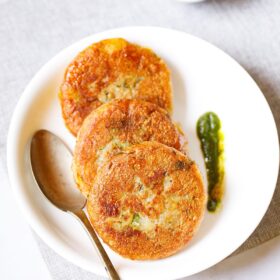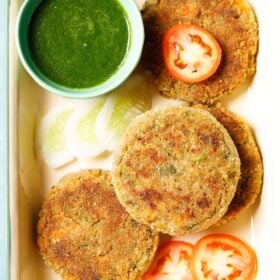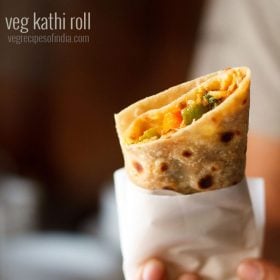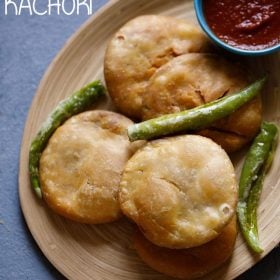Indian Street Food Recipes
Flaky and crunchy fried Samosa are one of the most popular street food snack in North Indian cuisine. They feature a pastry-like crust but are filled with savory and spiced potato and green peas for a hearty, delicious snack. This step-by-step recipe guide will help you to make the flakiest, tastiest, absolutely best Punjabi Samosa or Aloo Samosa from scratch!
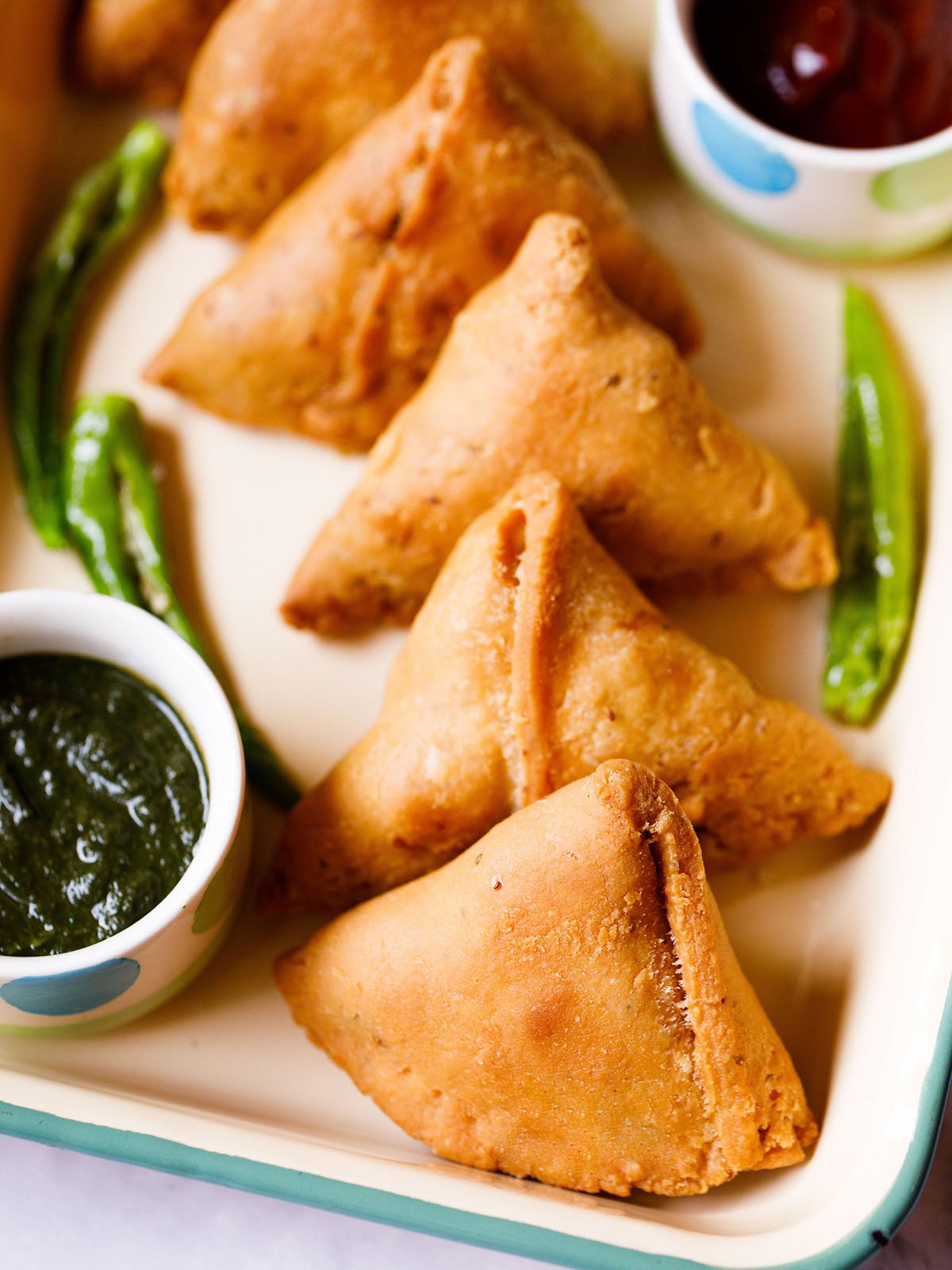
About Samosa Recipe
What makes this the best homemade samosa recipe? My foolproof instructions will guarantee that your potatoes and peas samosa are hearty with a perfectly flaky, crispy crust.
I use a bit less water than some other recipes to make my dough, which creates an ever flakier and crave-able samosa crust. (This is also the trick I use to make samosa pie, which is a great non-fried alternative to traditional samosa.)
Plus, the filling in these Punjabi Samosa is just fantastic. It’s super easy to prepare in a stovetop pressure cooker or using an Instant Pot and in a pan on the stove.
Table of Contents
Green peas and potatoes are blended with classic Indian spices for a warm, satisfying stuffing that will keep you wanting more.
With a perfect crust and comforting filling, this recipe is a real winner! Give it a try and you’ll be amazed at how simple and fun it is to make samosa recipe from scratch at home.
Our personal favorite is and will always be a Punjabi Samosa which is what this recipe is all about. The classic potato and green peas stuffing in this recipe is adapted from my cooking school notes.
I have also made a video which shows the shaping, stuffing and deep frying the Aloo Samosa. You can have a look at the video, if the photos don’t help.
How to Make Punjabi Samosa
Below is my complete step-by-step guide with photos for making the best Punjabi Samosa recipe from scratch.
You start by making the savory filling and pastry dough. Then assemble the Aloo Samosa, fry, and enjoy with your favorite dipping sauces and chutneys!
Cook Potato & Green Peas
1. The first step is to cook the potatoes and peas for the savory and spiced filling.
- To cook the potatoes and peas in a stovetop pressure cooker: Place 3 medium-sized whole potatoes (300 to 450 grams) and 2 to 2.5 cups water in a 3 or 4 litre pressure cooker. On top of the potatoes carefully set a small trivet and pressure cooker-safe bowl with ½ cup green peas. Pressure cook for 5 to 6 whistles or 7 to 8 minutes on medium to medium-high flame.
- If using an Instant Pot: Place 3 medium-sized whole potatoes in the steel insert of a 6 quart IP. Add 2 cups water. Place a trivet on top of the potatoes, and on top of the trivet set a bowl with ½ cup of green peas. Pressure cook on high for 20 to 25 minutes.
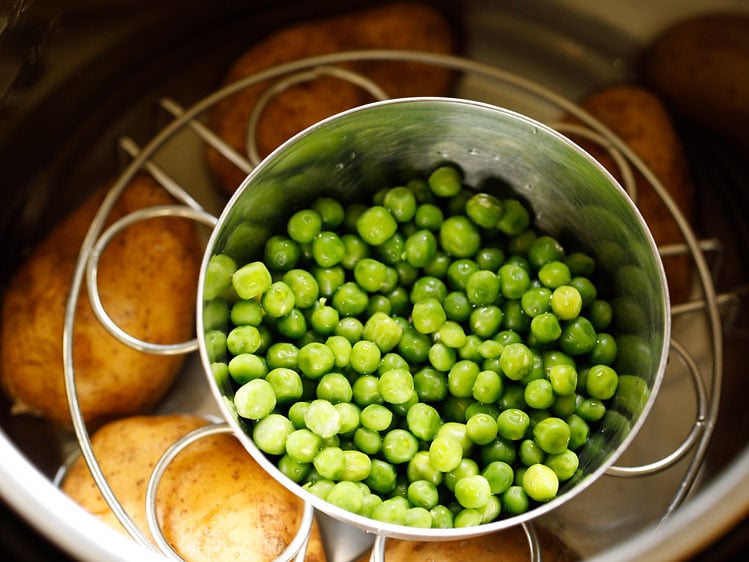
2. For the stovetop pressure cooker, remove the lid after all the pressure falls in the cooker.
For the Instant Pot, do a quick pressure release after 5 to 7 minutes. Check with a knife or fork to see if the potatoes are cooked well.
The knife or fork should be able to slide through easily if the potatoes are cooked properly.
If the potatoes are undercooked, then cook them for a few more minutes using the pressure cook function. Once done, drain the potatoes and peas in a colander and set aside to cool.
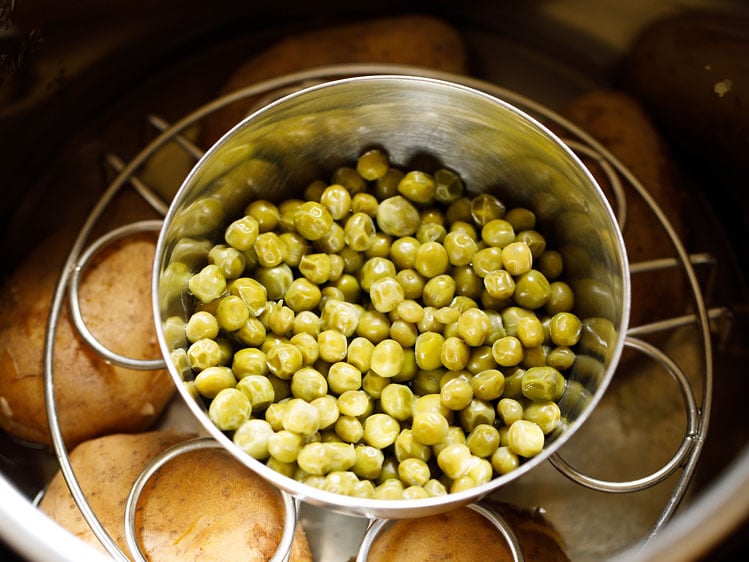
Roast and Powder Spices
3. Next, roast or toast the spices. This will help to release their flavors and should not be skipped!
To a small frying pan over low heat add the following spices:
- ½ inch cinnamon stick
- 1 clove, optional
- 1 green cardamom
- 3 black peppercorns
- ½ teaspoon cumin seeds
- ½ teaspoon fennel seeds
- 2 teaspoons coriander seeds
Heat the spices for just a few minutes until aromatic, being careful to not burn.
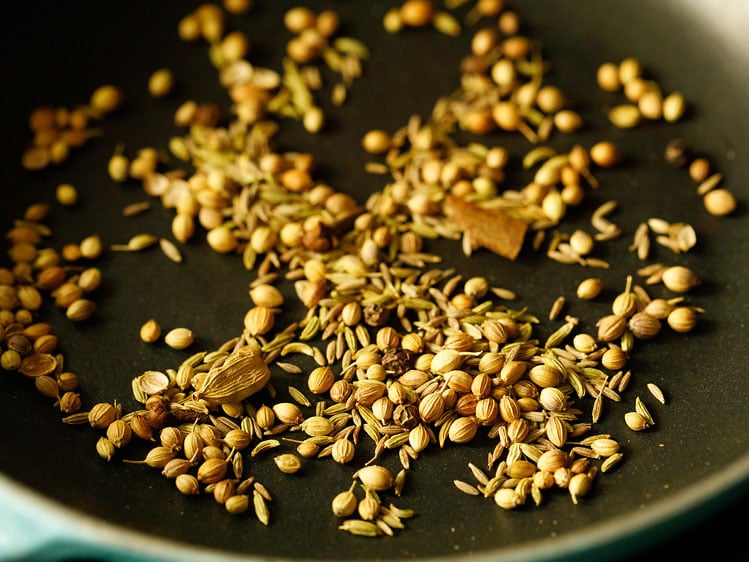
4. Remove the spices from the heat and allow to cool completely. Then, put them in a spice grinder or small mixer-grinder jar.
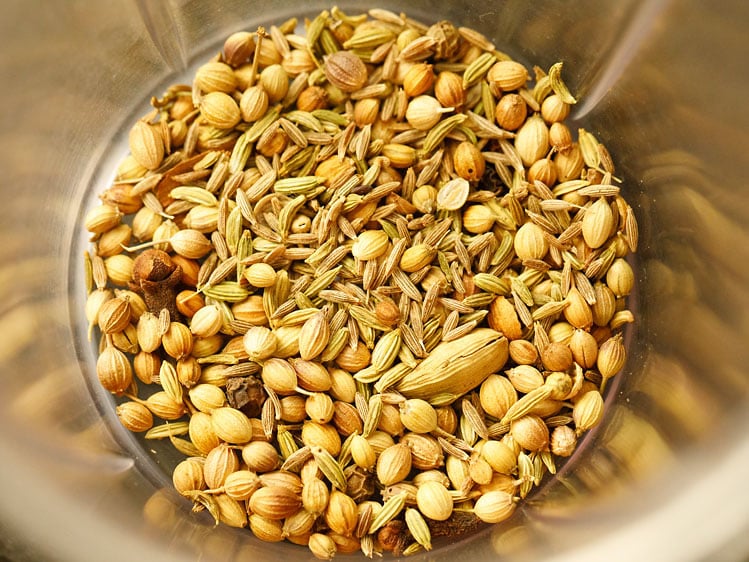
5. Grind the toasted spices to a semi-fine powder, and set aside.
Tip: If you are pressed for time to roast and grind the spices, then I have a solution for you.
Mix 2 teaspoons ground coriander (coriander powder), ½ teaspoon ground cumin (cumin powder), ½ teaspoon ground fennel (fennel powder) and ½ teaspoon garam masala powder in a small bowl.
Add this prepared spice mix at step 9 when the green peas and remaining ground spices are added.
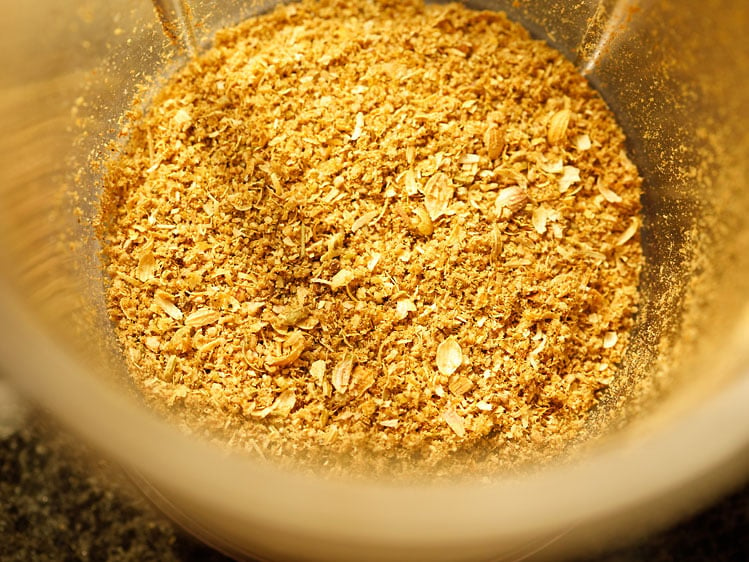
Make Potato Stuffing
6. Peel the skin off of the cooked potatoes, and chop them in ½ to 1 inch cubes.
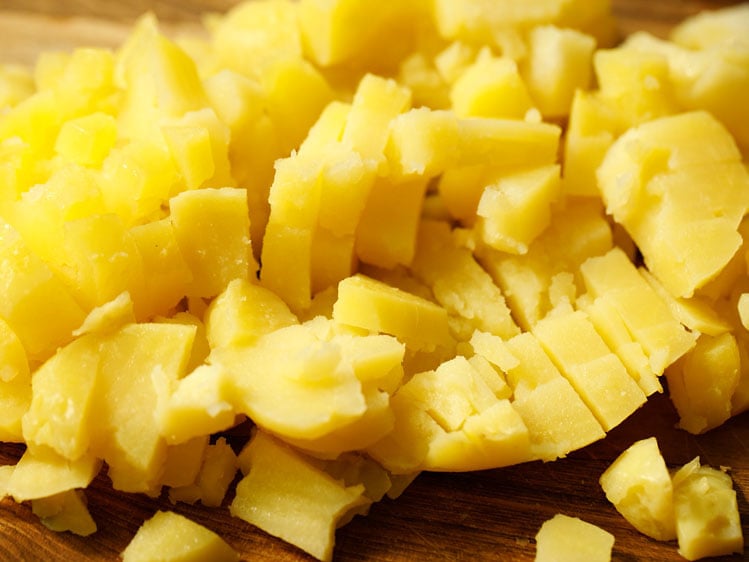
7. In a small skillet, heat 1 tablespoon oil. When the oil becomes medium hot then reduce the heat to low.
Crackle ½ teaspoon cumin seeds until fragrant. I used mustard oil as it really adds a punch in the stuffing.
You can use neutral oil like sunflower oil, safflower oil, grapeseed oil or canola oil.
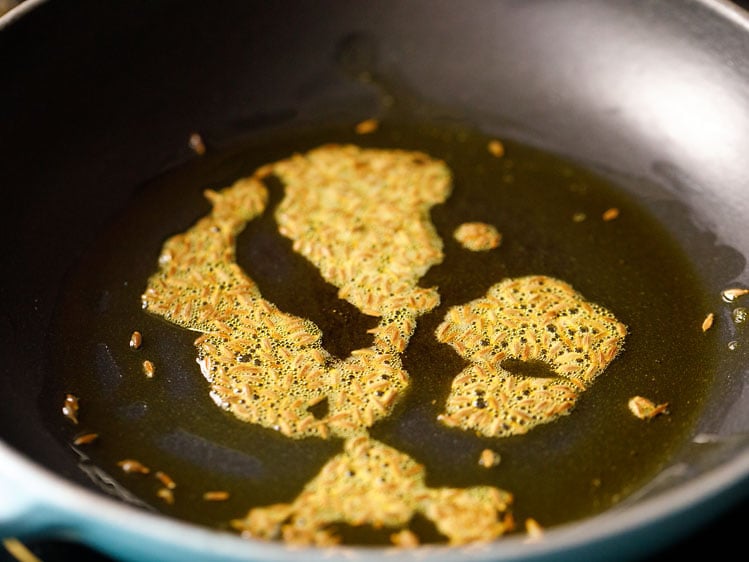
8. Keep the heat on low and add 1 teaspoon finely chopped or minced ginger and 2 teaspoons finely chopped green chillies. Sauté for a few seconds until the raw aroma of ginger goes away.
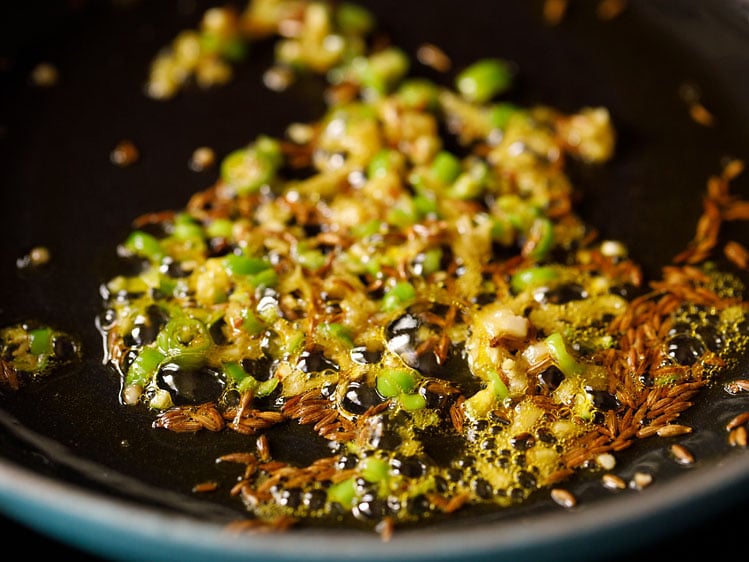
9. Now you can switch off the flame or keep flame to a low. Then add the cooked green peas, ½ teaspoon red chilli powder, 1 pinch of asafoetida (hing), the dry ground spice mix that we made and 1 to 2 teaspoons dry mango powder (amchur).
The mango powder is what gives the Punjabi Samosa filling its signature tangy flavor that balances so well with the savory, spicy flavors of the other stuffing ingredients.
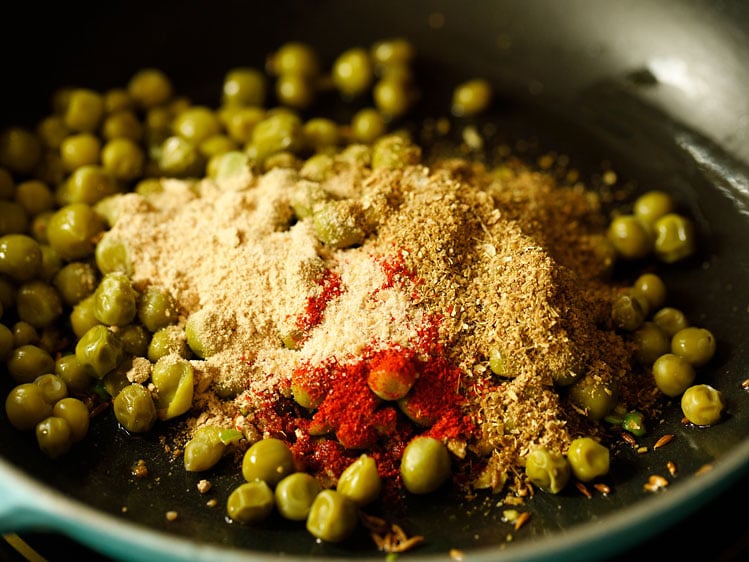
10. Stir together and sauté for a minute. You can add less or more dry mango powder depending upon personal taste.
I added 2 teaspoons as just 1 teaspoon was not quite enough sour flavor for me.
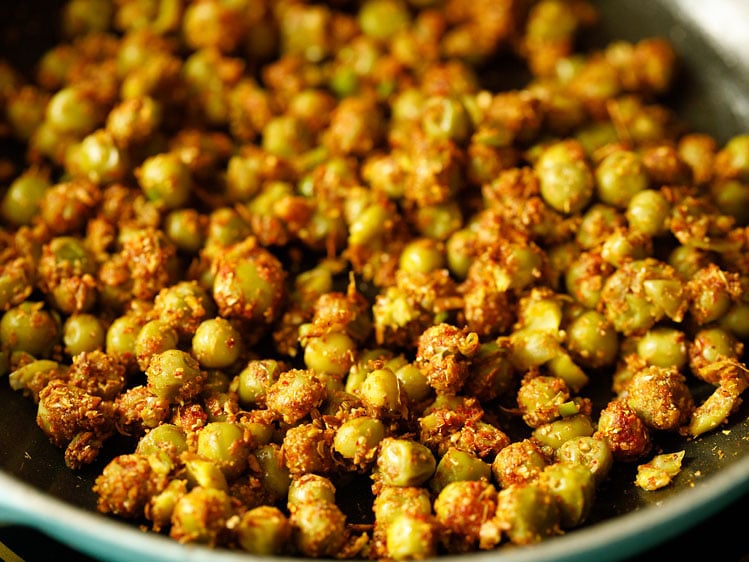
11. Next add potato cubes, salt as required and 1 tablespoon chopped coriander leaves (also known as cilantro) to the skillet.
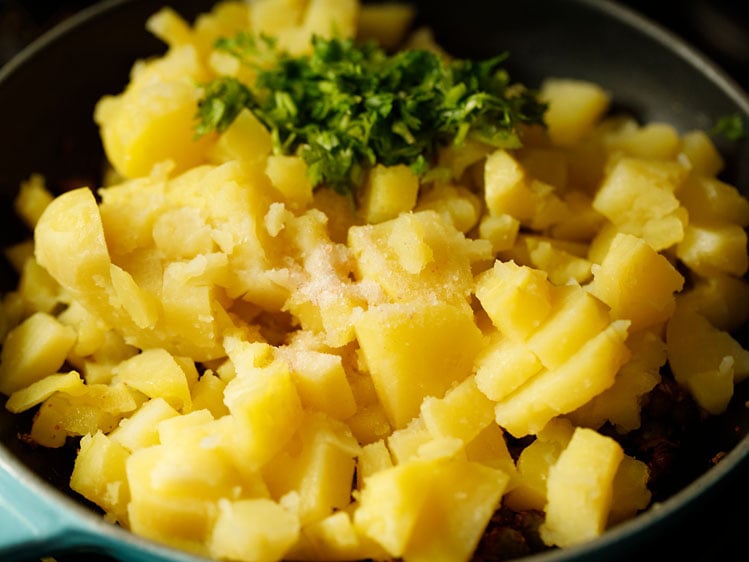
12. Mix very well and sauté for a minute. Check the taste, and add more of the spices, salt or dry mango powder if needed.
Cover and set the filling aside while you make the dough.
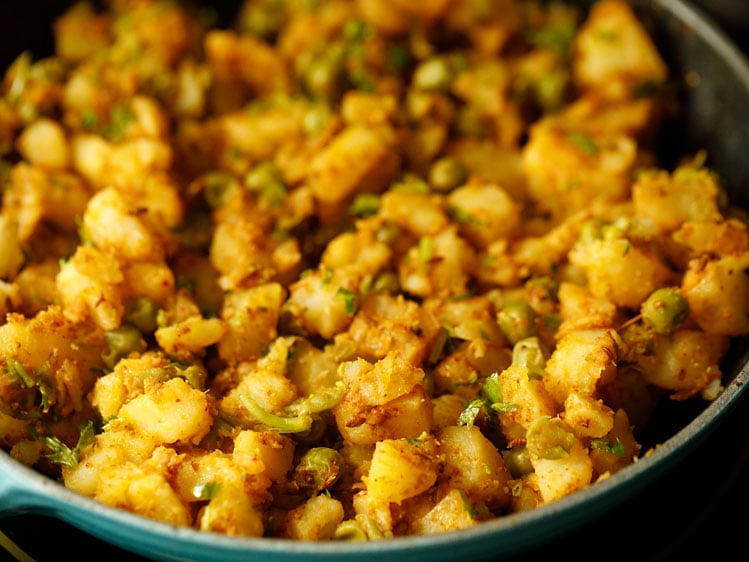
Make Samosa Pastry Dough
13. In a large mixing bowl combine 2 cups all-purpose flour (250 grams), 1 teaspoon carom seeds, 1 teaspoon salt and 6 tablespoons ghee (50 grams).
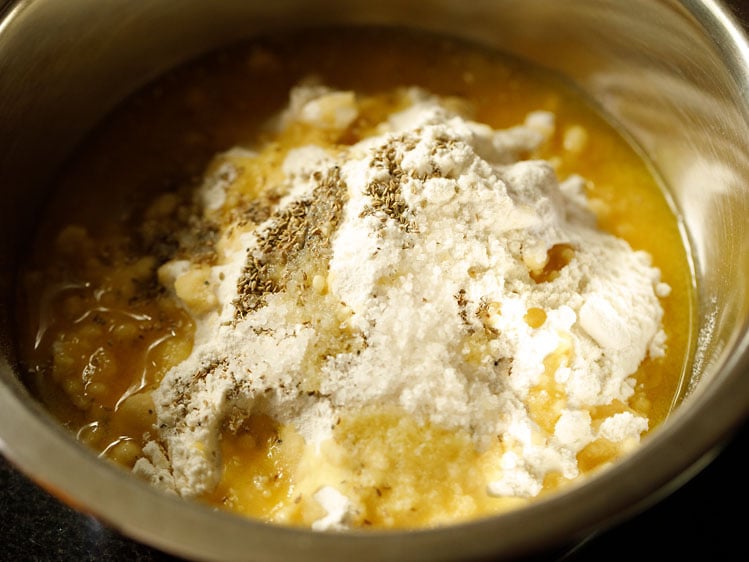
14. With your fingers, mix the ingredients together until they make a breadcrumb-like texture that holds its shape when you press a portion of the mixture.
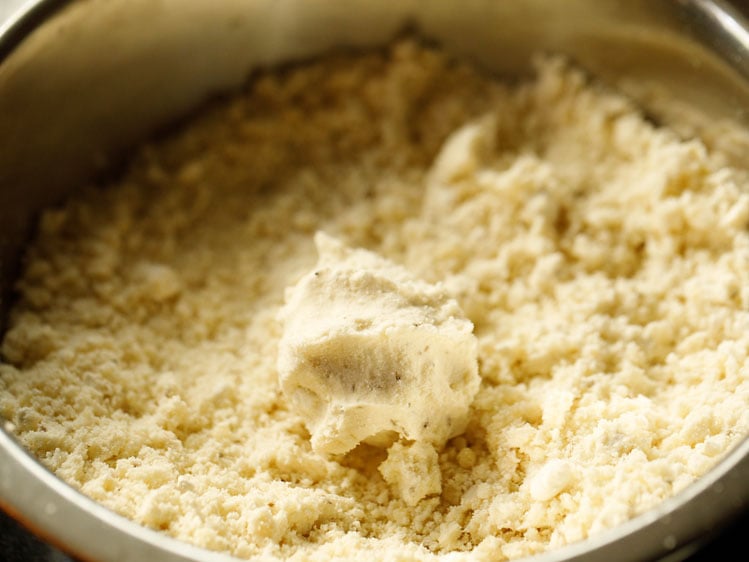
15. Then, working just a bit at a time, add in 7 to 8 tablespoons water in parts and knead.
You can add 1 to 2 tablespoons extra water if needed if the dough looks floury or dry.
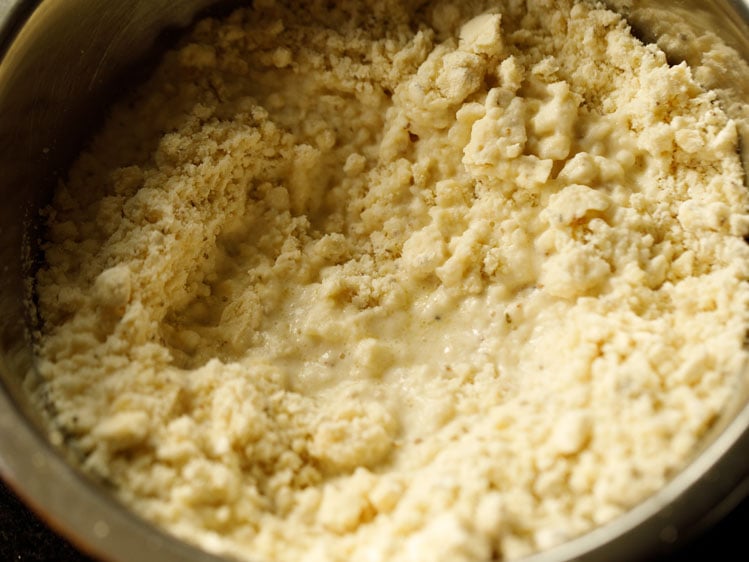
16. Continue kneading to form a firm, tight dough. It should not be soft or sticky. Cover the dough with a moist kitchen towel and let rest for 30 minutes.
In case if your dough becomes too moist or sticky then add a few tablespoons of flour. Mix and knead again to a firm dough.
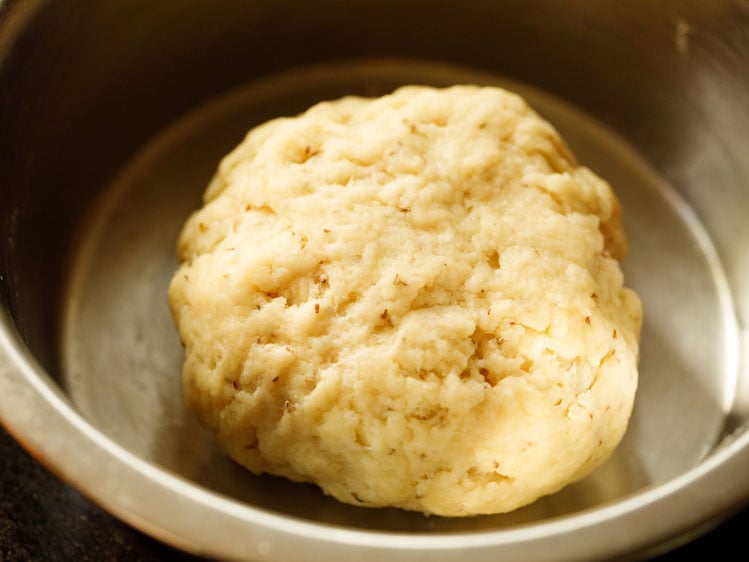
Assemble & Shape
17. After the dough has rested, divide it into 6 to 7 even pieces. Take each piece and gently roll in your palms first to smooth and soften. Place it on your work surface or on the rolling board.
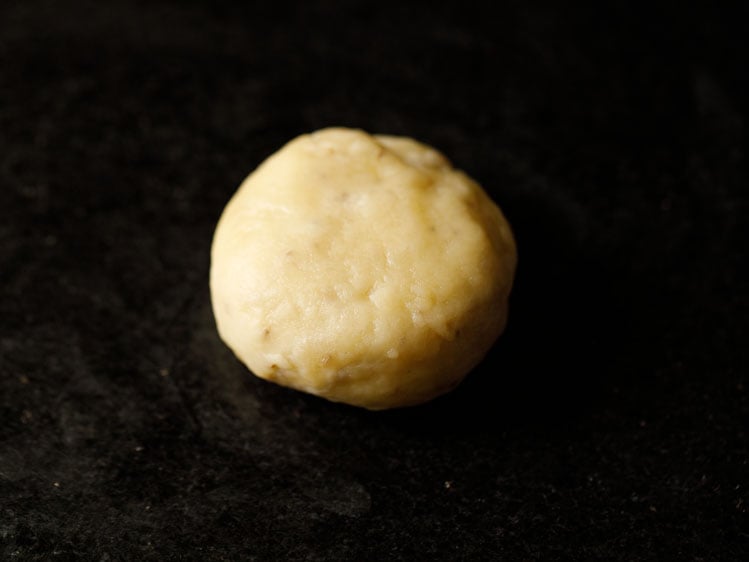
18. Then roll it with a rolling pin, being mindful to keep the thickness even at 1 mm and not too thin.
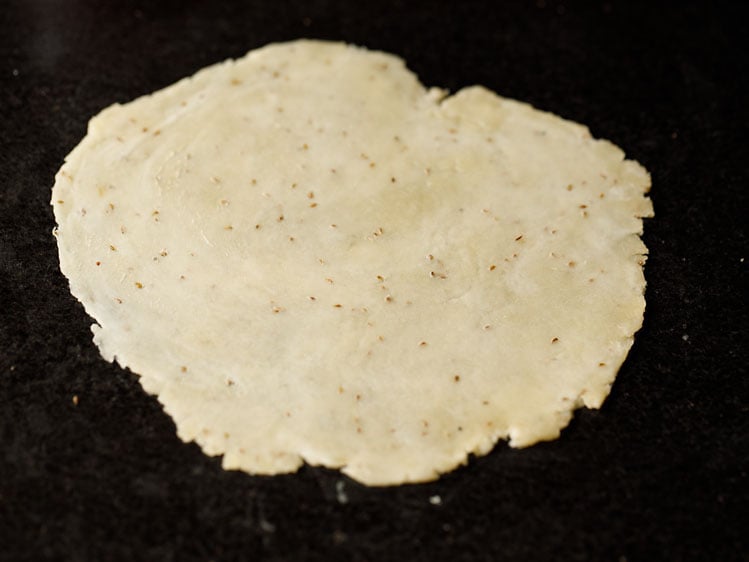
19. Cut the with a knife or a pastry cutter, right through the center of the rolled pastry dough.
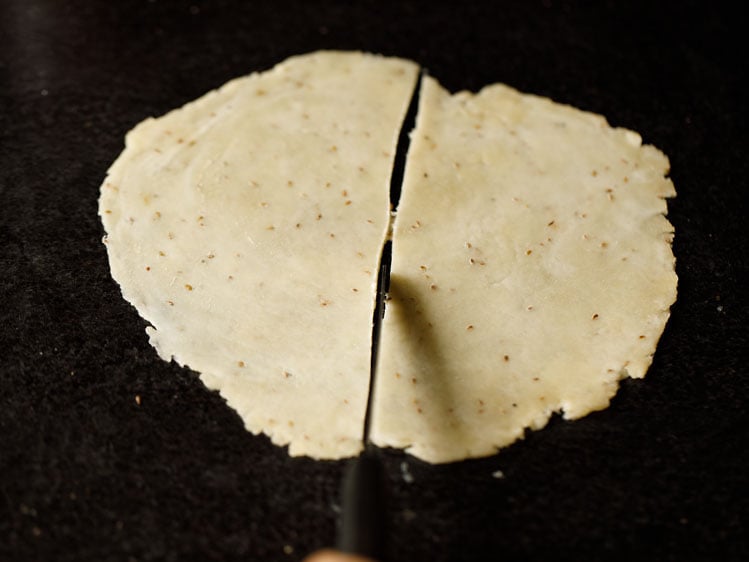
20. Use a rolling pin to gently flatten the half moon shape to make even.
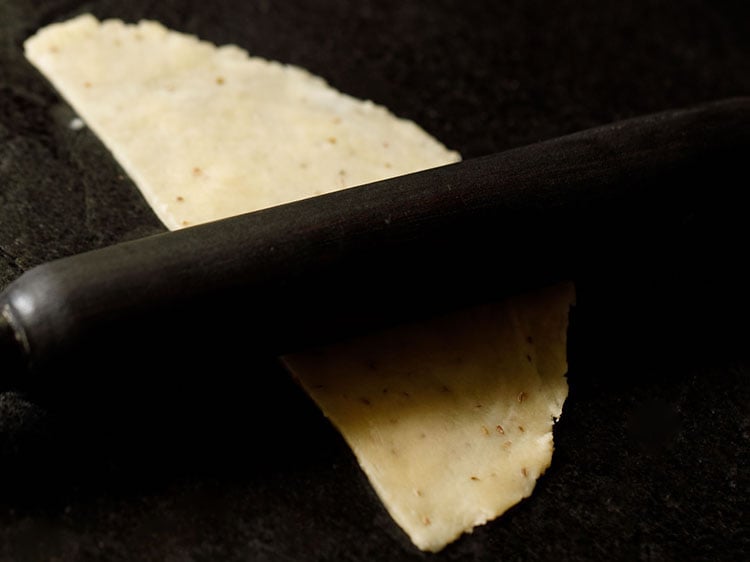
21. Use a pastry brush to lightly brush the dough with water around all of the edges.
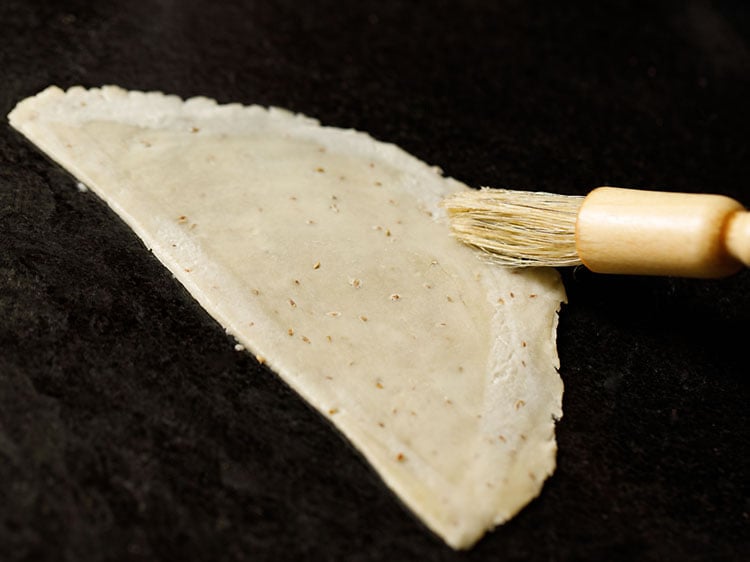
22. Next, fold to join the straight edged side together to form a cone, like shown in the photo below. Be sure to press the edges well so that they are sealed!
The cone is now ready to be stuffed with the potato and pea filling.
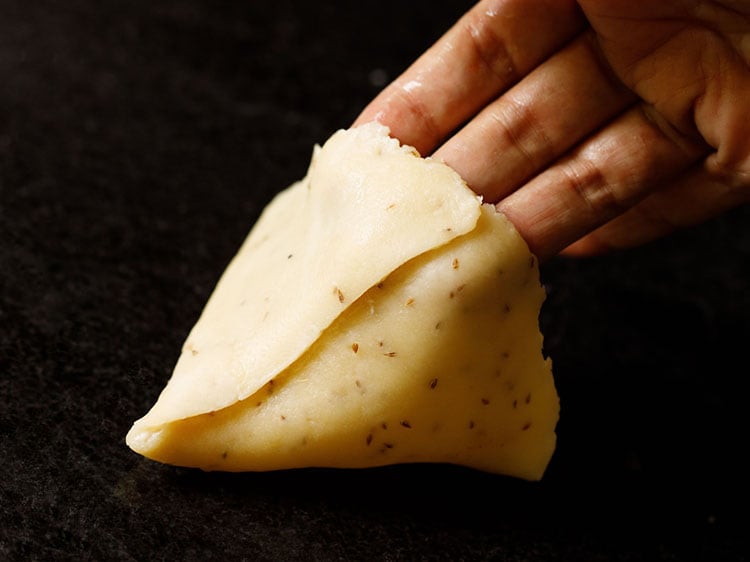
23. Carefully spoon and lightly pack the prepared potato and pea stuffing into the cone.
Make sure to not over or under-fill to prevent the samosa from bursting during the frying process.
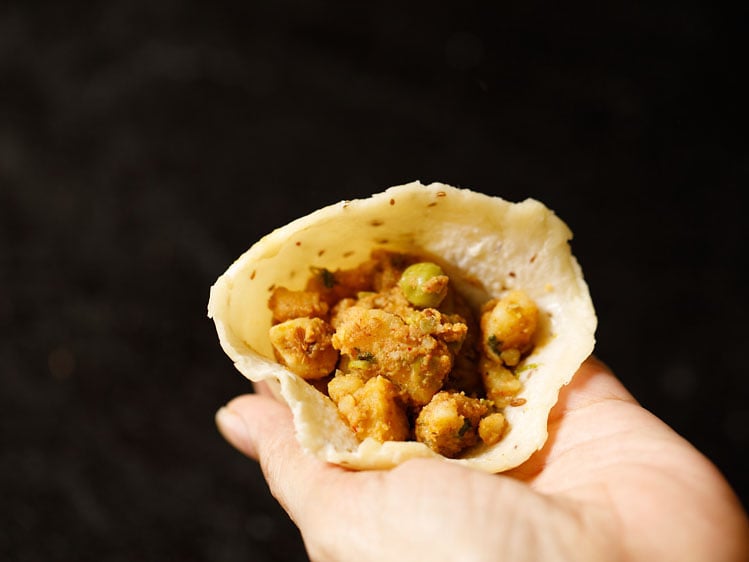
24. Crimp and pinch the edges to close as shown in photo below. This helps the samosa to stand once made.
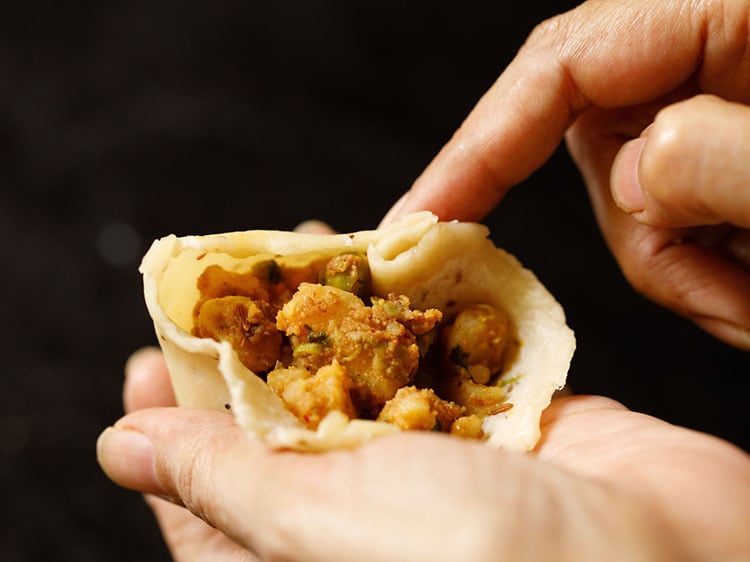
25. Evenly press all of the edges, making sure there are no cracks in the dough. The edges should be sealed very well so that the stuffing does not come out while frying.
Prepare all the samosa this way as described above, and cover with a moist kitchen napkin to keep them from drying out.
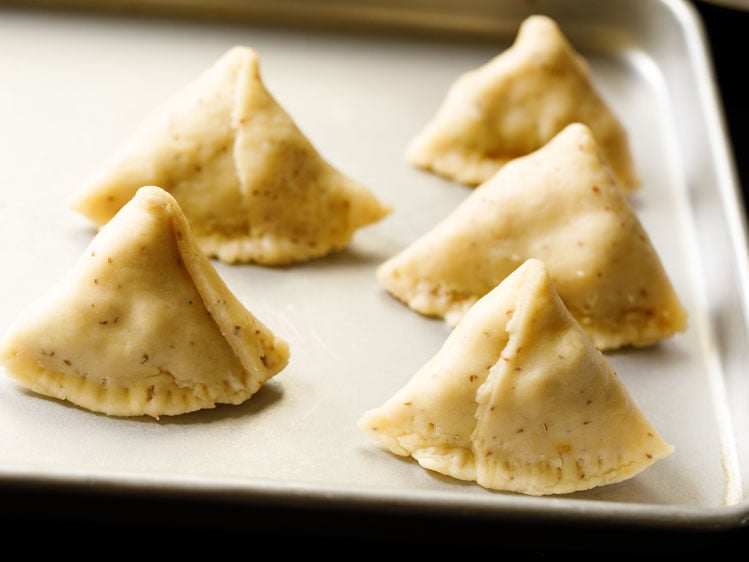
Deep Fry Samosa
The final step to making the best samosa is to fry them to a perfectly crisp golden brown.
Use any neutral flavored oil to deep fry – sunflower oil, canola oil, vegetable oil, safflower oil, grapeseed oil are some options.
26. Heat the oil for deep frying in a kadai or pan. Test the oil by adding a small piece of dough – it should come up quickly if the oil is hot enough for frying.
Once the oil becomes medium-hot, gently slide 3 to 4 of the prepared stuffed samosas into the oil, and then immediately reduce the heat to low.
Do not overcrowd the pan to ensure each one of them fries evenly!
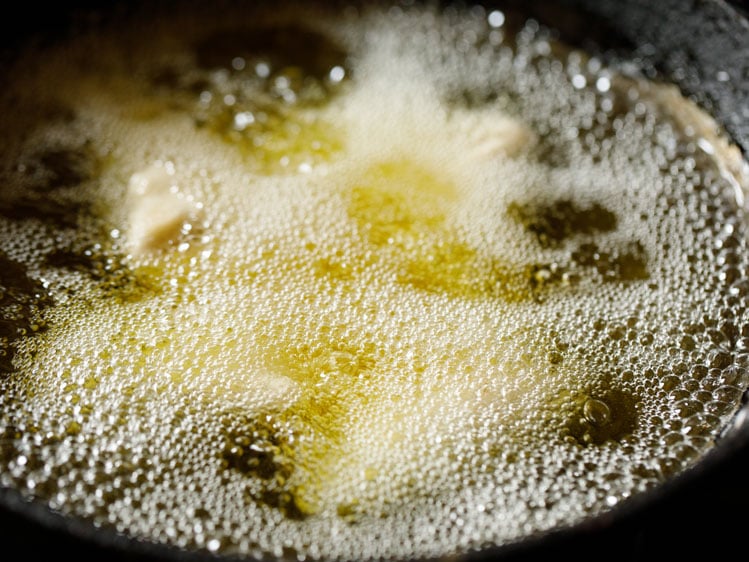
27. Fry them on low to medium-low heat, keeping an eye on them so they don’t burn.
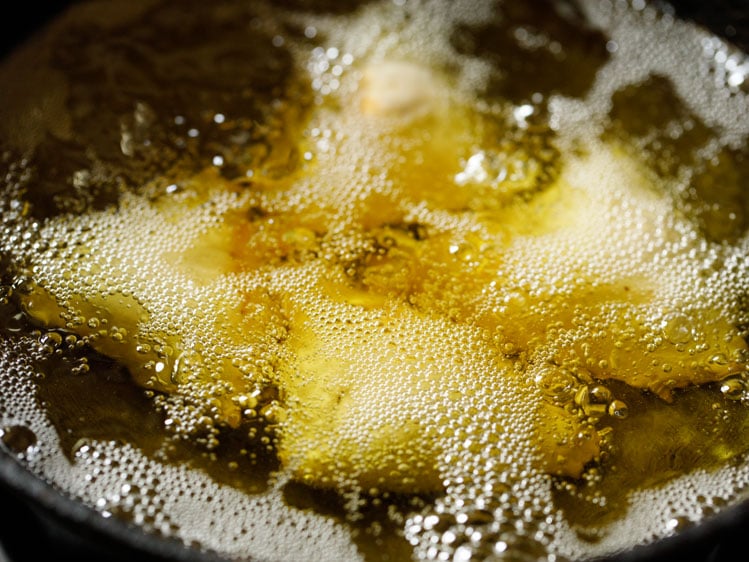
28. When one side is pale golden, use tongs or a slotted spoon or skimmer to gently turn each samosa over and continue frying.
This way you will have to turn a couple of times for even cooking. Be gentle and careful while turning them as they are heavy and oil can spill out.
Frying these take a lot of time, so you have to be calm and patient!
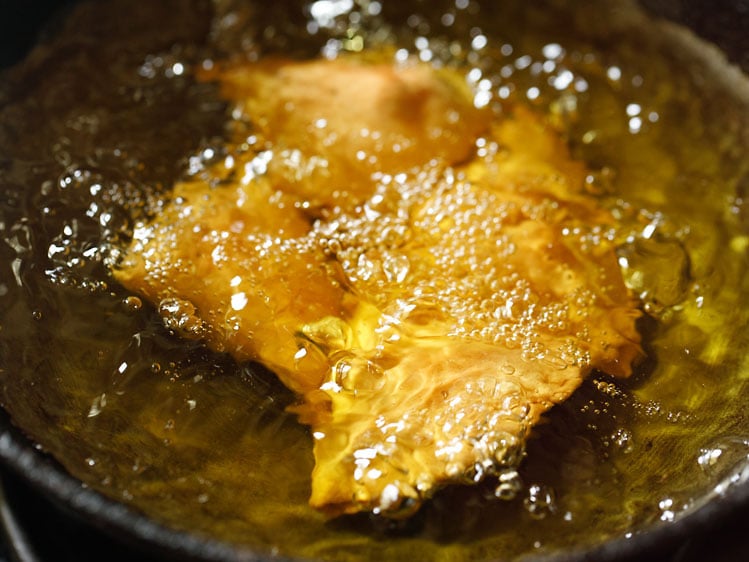
29. Fry until each aloo samosa is crisp and golden. The oil will stop sizzling once the samosas are fried well. They will become nicely crisp and golden.
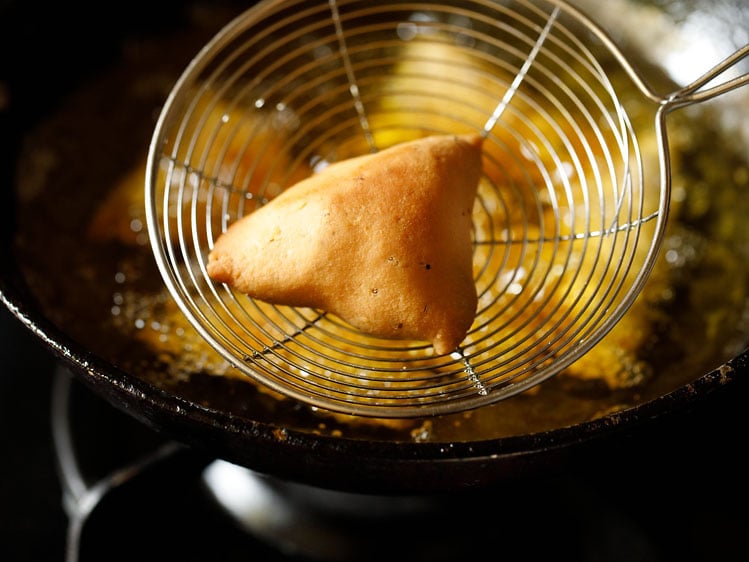
30. Use a skimmer spoon or spider spoon to carefully remove fried samosa from the oil, and place them on paper towels to remove extra oil.
Repeat the frying steps with the remaining batches of Aloo Samosa. Reduce the heat when you begin to fry the next batches. Regulate the heat as needed while frying these.
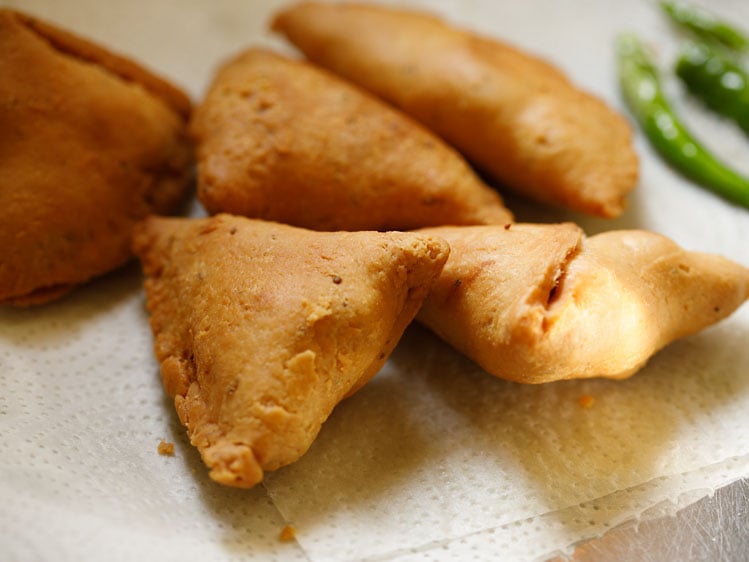
31. Serve Punjabi Samosa hot or warm or at room temperature with Coriander Chutney or Tamarind Chutney, or with a zesty tomato ketchup.
The pairing of Aloo Samosa with masala chai is irresistible and much loved in India.
You can also serve them with Chole Masala. This dish is popularly known as samosa chole. Another popular chaat snack made with potato samosa is Samosa Chaat.
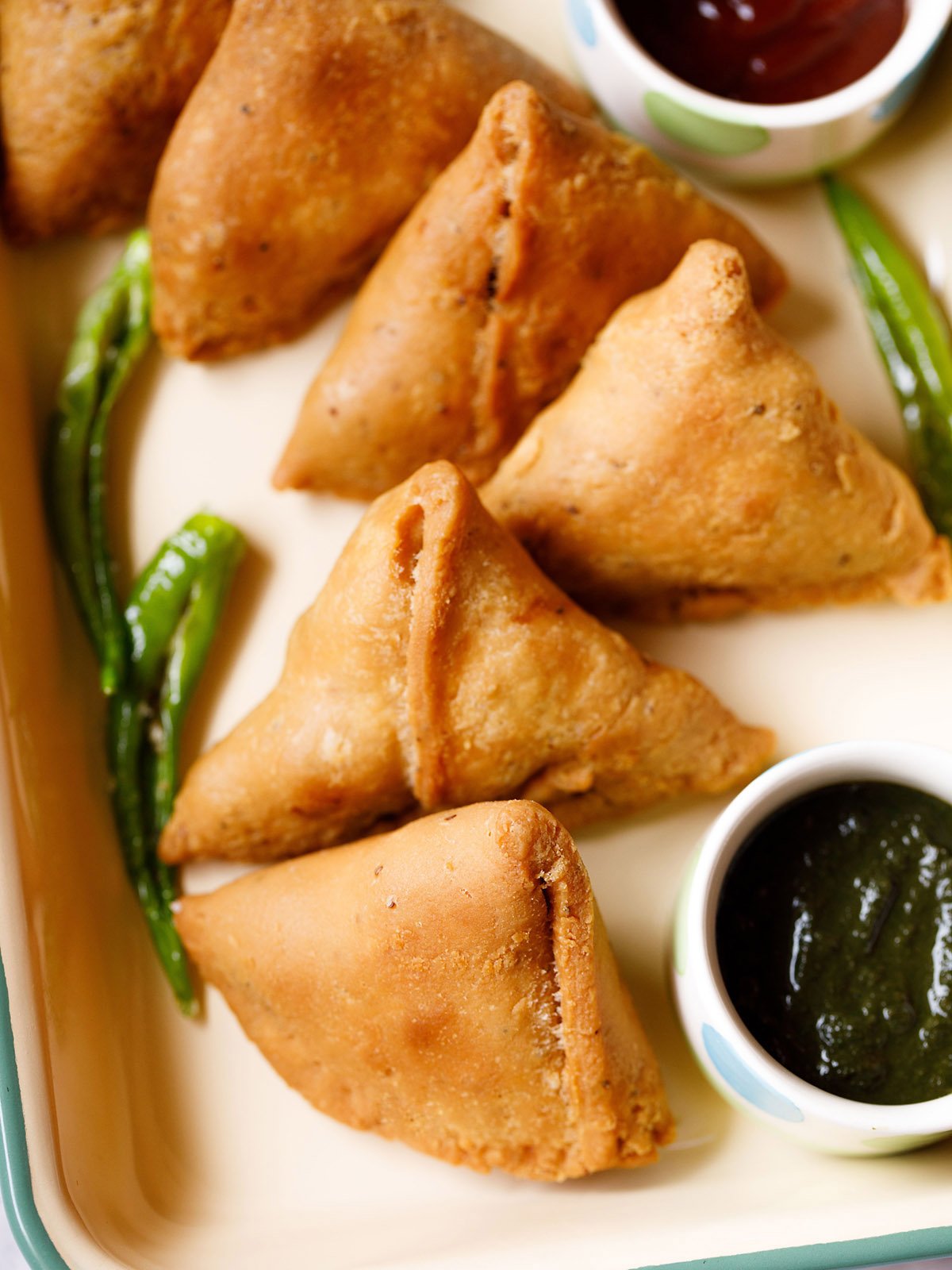
Stuffing Variations
There are many variations in a samosa stuffing depending on the region and state in India.
- In Delhi and Punjab, potatoes alone or a combination of peas and potatoes are common – where the potatoes or peas are not crushed or mashed. The potato cubes are cooked perfectly but in shape with a few green chilli pieces in the filing. There is a some sourness in this stuffing as dry mango powder or dry pomegranate powder are added. A few more spices are added as well.
- In some variations, raisins are also added which gives the samosa a sweet-sour taste. Sometimes cashews are also added for some crunch.
- In some places, the filling is totally mashed with plenty of spices added.
- If the green chilies are not added in the filling then fried green chilies are usually served separately.
- Some people also add ginger-garlic paste and on few rare occasions, I have found chopped carrots pieces also in the stuffing.
- A variation with mix vegetables is also made. Veggies like peas, carrots, cauliflower and potatoes are added.
- Onion samosa is another variation where a spiced mixture of onions and poha (flattened rice) is filled in the samosa.
- Sweet samosa is also made with a stuffing of khoya (mawa), nuts and dry fruits. This is made usually during Indian festivals like Diwali or Holi. These samosas are also known as khoya samosa or dry fruit samosa.
- A variation is also made with paneer cubes added in the stuffing.
- Cocktail samosa is a small sized samosa stuffed with a dry filling of spices, nuts and dry fruits.
Expert Tips
So you must be wondering what should be the perfect proportions of ingredients in the pastry dough and the correct frying method – to get that flaky and crispy crust in the aloo samosa recipe. I break it down for you in detail.
1. Proportion of fat
The amount of fat (which we call as “moyen or moyan” in Hindi) has to be in the correct proportion in the pastry dough. One of my culinary expert friend always suggests to add ⅕ of fat to 1 part of flour in weight.
Example: For 1 kilogram of flour, you have to add 200 grams of fat. In this recipe, I have kept the same ⅕ proportion of fat – which is 50 grams for 250 grams of flour.
2. Proportion of water
A samosa crust dough has to be kneaded to a tight and firm dough. The dough should not be soft like a bread or roti dough. So you need to add less water when kneading. The amount of water that will be added depends on the quality of the flour. Thus add water in parts when you knead the dough.
3. Rolling samosa pastry
You have to roll the crust evenly keeping 1 mm thickness all over. Do not roll the crust too thick. A thick crust will take up plenty of frying time resulting in a hard texture.
Do not roll the dough too thin. It won’t be able to contain the potato stuffing and burst in oil. So do keep in mind these tips while rolling the dough.
Two Frying Techniques
There are two frying techniques to get that perfect crispy flaky crust in a samosa.
1. Frying at a low temperature
In this method, firstly heat the oil at a medium or medium-high temperature. Then add the samosa into the hot oil. As soon as you add them to the hot oil, reduce the heat to a low or medium-low and fry them on a low heat.
This ensures that they do not absorb too much oil. If you directly put the samosa in a less hot oil, they soak up too much oil. If you fry them in a very hot oil, then tiny air bubble pockets can form on the crust and the inside part of the crust will be undercooked.
2. Frying twice
This is a little lengthy method and the one which I will suggest you to try while making samosas if you have plenty of time. In this method initially you have to lightly fry the them not allowing them to become golden – just that the dough should look cooked.
Add the samosas in hot oil and remove them when the crust has become opaque and creamish white. Fry until lightly fried so that when you remove them they will not break. Set them aside. Then lower the heat of oil and fry them again until they are golden.
With both the methods, the final samosa will be crisp & flaky from outside and cooked well from inside – like the one you get in the Indian sweet stores and there will be no air pockets on the crust.
How to make Samosa in an air fryer
If you have an air fryer then do try making samosa in it. You will be pleasantly surprised with the texture of the air fried samosa. They do taste similar to the fried ones, minus the extra oil.
For air-frying, preheat air fryer at 180° C/356° F for 10 minutes. Brush them lightly with oil and air-fry at 180° C/356° F until they are golden.
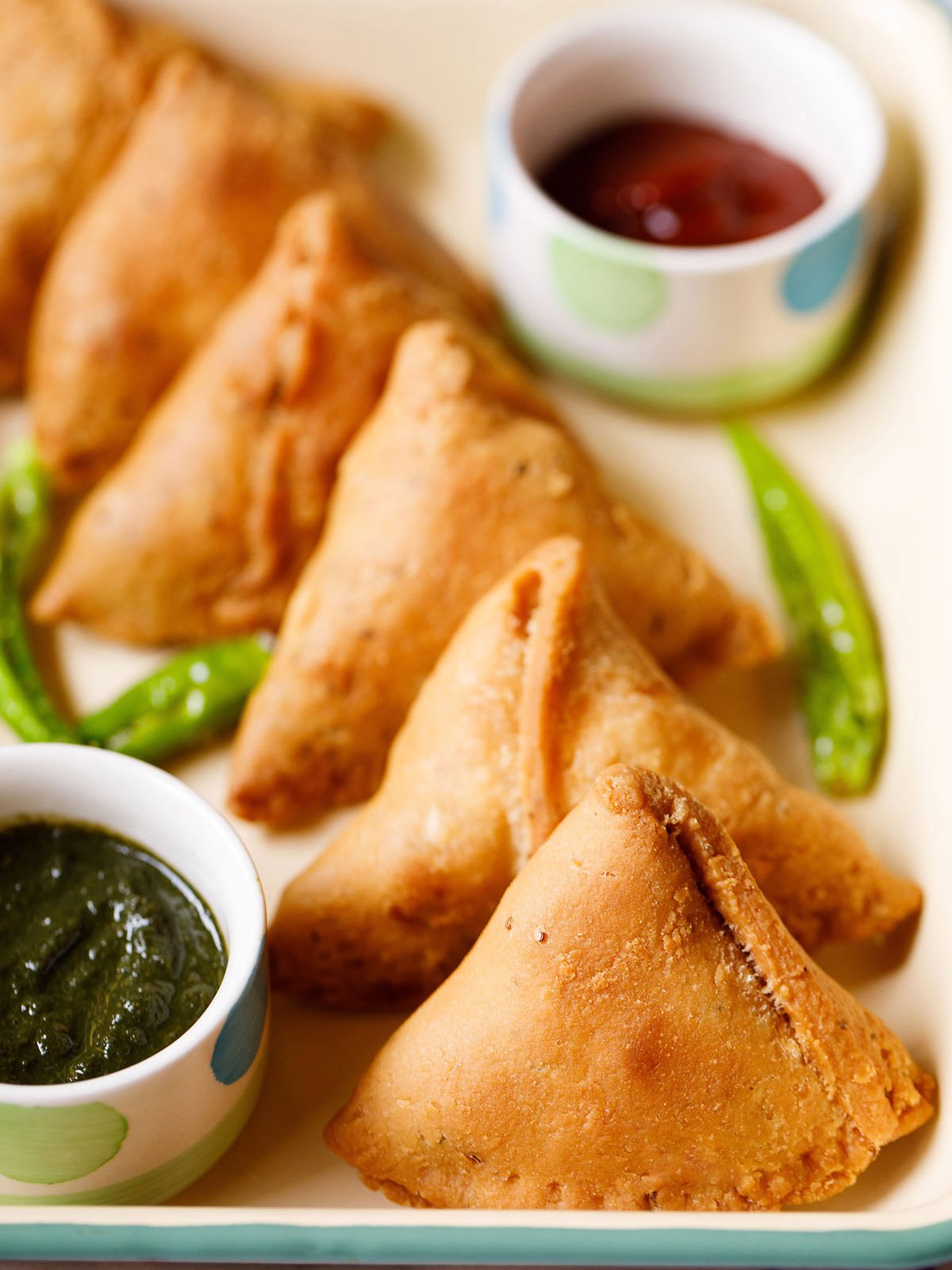
FAQs
I have compiled below answers to questions based on the queries asked by readers in the comments.
Add 1 teaspoon lemon juice to the potato stuffing. If you have dried pomegranate powder, then add 2 teaspoons of it.
You can freeze them. Either shape them and then freeze or you can first fry them till the crust becomes opaque and then freeze them. This way they will stay better for a longer time.
Before frying, let them come to room temperature and then fry. If fried when they are still cold, then they absorb more oil.
A few air pockets are fine, but the outer fried crust should not be covered with a lot of air pockets. If the dough is soft, then the air pockets occur on the crust.
Too much moisture in the dough makes the crust soft as well as gives it plenty of air pockets. While frying, if the oil is too hot, air pockets appear on the crust.
1. If using puff pastry sheets, then bake samosa. You can even air fry.
2. For spring roll wrappers, you can either fry or bake them.
3. With phyllo dough sheets bake them.
Samosas can become soft due to two reasons. Either the dough is soft or the oil is at a too low temperature while frying.
When you knead the dough, make sure that dough is tight and stiff. It should not be soft like bread or roti dough.
You can easily store it for a couple of hours at room temperature. If you don’t plan to eat them at all, then store them in an air-tight box (dabba) in the fridge. When serving you can warm them on a tawa or in an oven.
Yes of course you can air-fry them. Please do read the air-frying part I have described above.
Yes definitely. Bake in a preheated oven at 180° C/356° F for 30 to 35 minutes until the crust becomes crisp and golden. Preheat the oven for 10 minutes at the same temperature before you bake.
More Questions Answered
Can I make this recipe with whole wheat flour?
Yes, you can do that. In fact many Indian recipes that use (all purpose flour) can be easily made with whole wheat flour. Just remember to add more water while kneading as whole wheat flour absorbs more water.
However, with whole wheat flour the crust might become dense and will not be as flaky as made with all-purpose flour.
What is the recipe for the fried green chillies served with Punjabi Samosa?
The first method is to slit the green chillies keeping them whole. Shallow fry or deep fry them till you see a few light golden blisters on them. Later sprinkle some salt on the fried green chilies and mix. You can also sprinkle some chaat masala or amchur powder.
The second method is to stuff a mixture of amchur powder (dry mango powder) and salt in slit green chilies. Shallow fry them and then serve.
How to make a vegan version of this recipe?
Yes. To make a vegan samosa, use a neutral tasting oil instead of ghee (clarified butter) while making the dough crust.
Can I add onions in the stuffing?
Usually in an authentic Punjabi samosa recipe, onions and garlic are never added. But we can always make our own variations and be creative. So you can add onions and garlic if you prefer.
Both the onions and garlic will change the taste of stuffing considerably. In fact there is a variant where onion is the star ingredient in the stuffing and is a popular street snack called as onion samosa.
What can I do with leftover samosas?
You can warm it on a tawa (griddle) or oven until warm (at 170° Celsius in a preheated oven) and have them with bread, pav (dinner rolls) or roti. A great way to use them up is the awesome Indian street food of samosa chaat.
More Popular Indian Snacks
Snacks Recipes
Indian Street Food Recipes
Snacks Recipes
Please be sure to rate the recipe in the recipe card or leave a comment below if you have made it. For more vegetarian inspirations, Sign Up for my emails or follow me on Instagram, Youtube, Facebook, Pinterest or Twitter.
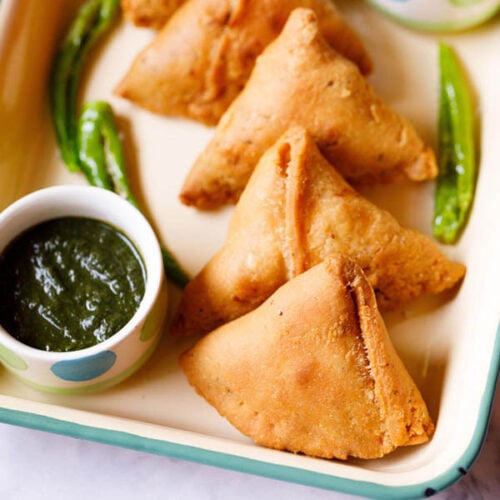
Samosa Recipe (With Potato & Green Peas)
Ingredients
For making samosa pastry
- 2 cups all-purpose flour (maida), 250 grams
- 1 teaspoon carom seeds
- 1 teaspoon salt or add as required
- 6 tablespoons Ghee (clarified butter), 50 grams
- 7 to 8 tablespoons water or add as required
For cooking potato & peas
- 3 potatoes medium-sized, 300 to 350 grams or 3 cups chopped boiled potatoes
- ½ cup green peas – 180 grams, fresh – can use frozen peas
- 2 cups water – for steaming
Other ingredients
- 1 tablespoon oil – I used mustard oil. sunflower, canola, grapeseed oil can be used
- ½ teaspoon cumin seeds
- 1 teaspoon ginger – finely chopped, or 1 inch peeled ginger
- 2 teaspoons green chillies – finely chopped or 2 tsp finely chopped serrano peppers or 1 to 2 green chillies
- ½ teaspoon red chili powder or cayenne pepper
- 1 pinch asafoetida (hing) – optional
- 1 to 2 teaspoons dry mango powder (amchur)
- salt as required
- 1 tablespoon coriander leaves (cilantro), chopped
- oil for deep frying – as required, any neutral flavored oil
Whole spices to be ground
- ½ inch cinnamon
- 1 clove – optional
- 3 black peppercorns
- 1 green cardamom
- ½ teaspoon cumin seeds
- ½ teaspoon fennel seeds
- 2 teaspoons coriander seeds
Instructions
Making the samosa pastry dough
- Take the flour, carom seeds, salt in a bowl. Mix well and add ghee.
- With your fingertips rub the ghee or oil in the flour to get a breadcrumb like consistency.
- The whole mixture should clump together when joined and not fall apart.
- Add water in parts and knead to a firm dough.
- If the dough looks dry or floury, then add 1 to 2 tablespoons more water and knead.
- Cover the dough with a moistened napkin and set aside for 30 minutes.
Making potato and green peas stuffing
- Steam or boil the potatoes and peas till are cooked completely. Drain them of any extra water in a colander or sieve.
- Peel the boiled potatoes and chop them into small cubes
- Dry roast all the whole spices mentioned in the above list until fragrant taking care not to burn them.
- When the spices are warm or cool at room temperature, grind them in a dry grinder or coffee grinder to a semi-fine or fine powder.
- Heat oil in a pan. add the cumin seeds and crackle them.
- Add the ginger and green chillies. Sauté for a few seconds until the raw aroma of ginger goes away.
- Add the steamed green peas, red chili powder, the freshly ground spice powder, dry mango powder and asafoetida.
- Stir and sauté on a low heat for 1 to 2 minutes.
- Add the potato cubes. Mix very well and sauté for about 2 to 3 minutes on low heat with frequent stirring.
- Set aside the potato filling aside to cool at room temperature.
Assembling & shaping samosa
- After resting the dough for 30 minutes, divide the dough in 6 equal pieces.
- Take each piece and roll in your palms first to make a smooth ball.
- Then roll it with a rolling pin keeping the thickness to 1 mm throughout.
- Cut with a knife or a pastry cutter through the center of the rolled samosa pastry.
- With a brush or with your finger tips, spread some water all over the edges.
- Join the two straight ends forming a cone shape.
- Press the edges so that they get sealed well.
- Stuff the prepared samosa cone with the prepared potato-peas stuffing.
- Pinch a part on the edge (check the video & photos). This helps the samosa to stand once it is shaped.
- Press both the edges. Be sure there are no cracks.
- Prepare all the samosa this way and keep covered with a moist kitchen napkin.
Frying Samosa
- Now heat oil for deep frying in a kadai or pan. Once the oil becomes hot (test by adding a small piece of dough – it should come up quickly once added to the hot oil). Gently slide the prepared stuffed samosa & quickly reduce the flame to low.
- Turn over in between and fry until golden. Drain the fried samosa on paper towels to remove excess oil.
- Fry them in batches. For frying the second batch, again increase the temperature of the oil to medium-heat. Do not overcrowd the pan while frying.
- Add the samosa and then lower the heat, thereby decreasing the temperature of oil.
- This way fry all the samosa in batches.
Serving suggestions
- Serve samosa hot or warm with coriander chutney, tamarind chutney or tomato ketchup.
- They can also be served with a yogurt dip or plain raita. Another way is to serve it with chana masala (chickpea curry).
- We usually pair samosa with masala chai or ginger chai.
- Even bread or pav (Indian bread rolls) can be served with it.
- Whatever you serve this snack with, remember to have hot masala chai with it.
Video
Notes
- Roasting whole spices: If you are short of time to roast and grind the whole spices, then in a small bowl, simply mix 2 teaspoons ground coriander (coriander powder), ½ teaspoon ground cumin (cumin powder), ½ teaspoon ground fennel (fennel powder) and ½ teaspoon garam masala powder. Add this prepared spice mix at the step when the green peas and remaining ground spices are added while making the stuffing mixture.
- Dry mango powder: Replace mango powder with 1 teaspoon lemon juice or 2 teaspoons dry pomegranate powder.
- Green peas: Simply skip if you do not have these.
- Asafoetida: Skip it completely if you cannot find asafoetida in your city.
- All-purpose flour: You can use pastry flour and even whole wheat flour. You may need to add more water when using whole wheat flour.
- Ghee: Replace ghee with a neutral tasting oil.
- Use the amount of fat as specified in the recipe to get a flaky crust.
- Add water just enough to help you form the dough. Do not make the dough soft like a bread or roti dough. The dough should be firm and tight.
- A soft samosa dough will make air pockets happen on the crust. Too much moisture in the dough makes the crust soft as well as gives it plenty of air pockets.
- Fry samosa on a low to medium-low heat. The oil should not be medium-hot or at a high temperature as this will result in having air-pockets on the crust and will leave the crust undercooked from inside.
- The oil for deep frying can be a neutral flavored oil like sunflower, safflower, canola oil or any good vegetable oil.
- You can shape samosa and freeze them or you can fry them until the crust becomes opaque and then freeze.
- The fried samosa can be kept at room temperature for some hours. If you are not able to finish them all, then store them in an air-tight container in the fridge for a couple of days. When serving you can warm them on a skillet or in an oven until warm (at 170 degrees celsius in a preheated oven).
- Air-frying: Preheat air fryer at 180 °Celsius for 10 minutes. Brush samosa with oil and air fry at 180° Celsius till the crust is golden.
- Baking: Bake samosa in a preheated oven at 180° C/356° F for 30 to 35 minutes or until the crust becomes crisp and golden.
Nutrition Info (Approximate Values)
Samosa recipe from the archives was first published on November 2013.
